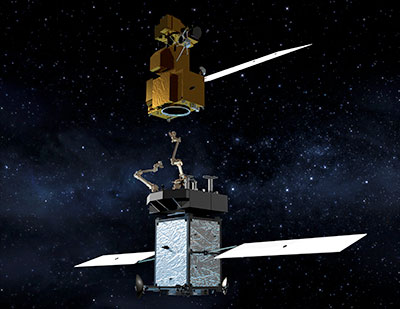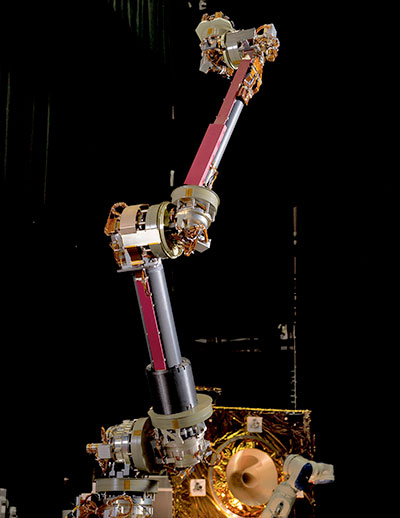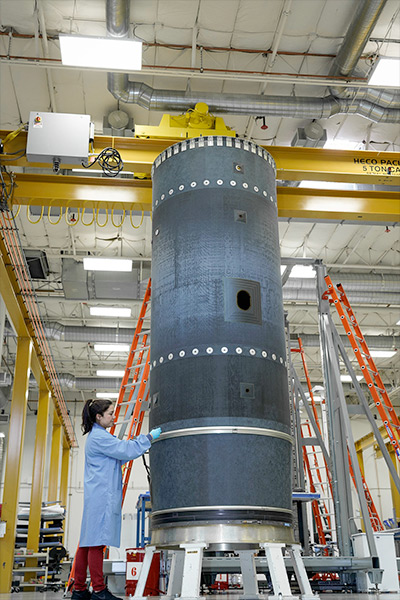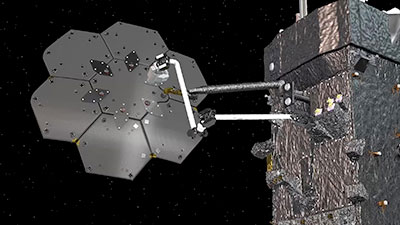|
|

|
|
Author
|
Topic: NASA's Restore-L mission to refuel Landsat 7
|
Robert Pearlman
Editor Posts: 43182
From: Houston, TX
Registered: Nov 1999
|
 posted 06-24-2016 05:42 PM
posted 06-24-2016 05:42 PM
   
NASA release NASA's Restore-L Mission to Refuel Landsat 7, Demonstrate Crosscutting TechnologiesDisruptive technologies have often changed the course of history, breaking the status quo and unlocking possibilities that have yet to be imagined. Building on a history of upgrading and maintaining assets in space, NASA is developing a new capability while creating a paradigm-shift: robotic satellite servicing. In May, NASA officially moved forward with plans to execute the ambitious, technology-rich Restore-L mission, an endeavor to launch a robotic spacecraft in 2020 to refuel a live satellite. The mission – the first of its kind in low-Earth orbit - will demonstrate that a carefully curated suite of satellite-servicing technologies are fully operational. The current candidate client for this venture is Landsat 7, a government-owned satellite in low-Earth orbit.  Above: The Restore-L servicer extends its robotic arm to grasp and refuel a client satellite on orbit. Beyond refueling, the Restore-L mission also carries another, weighty objective: to test other crosscutting technologies that have applications for several critical upcoming NASA missions. As the Restore-L servicer rendezvous with, grasps, refuels, and relocates a client spacecraft, NASA will be checking important items off of its technology checklist that puts humans closer to Mars exploration. Restore-L technologies include an autonomous relative navigation system with supporting avionics, and dexterous robotic arms and software. The suite is completed by a tool drive that supports a collection of sophisticated robotic tools for robotic spacecraft refueling, and a propellant transfer system that delivers measured amounts of fuel at the proper temperature, rate, and pressure. Future candidate applications for individual Restore-L technologies include on-orbit manufacturing and assembly, propellant depots, observatory servicing, and orbital debris management. NASA is also directly applying several Restore-L technologies to the Asteroid Redirect Mission. The robotic vehicle of NASA's Asteroid Redirect Mission directly leverages Restore-L's autonomous rendezvous system, avionics, dexterous robotics and software, and tool drive and other systems. This mission, along with the Wide-Field Infrared Survey Telescope (WFIRST) observatory, is being designed to be refuelable. NASA's second, equally important objective for Restore-L is to infuse its technologies to domestic commercial entities to help jumpstart a new, competitive industry in robotic satellite servicing, an area ripe with possibility. "Restore-L effectively breaks the paradigm of one-and-done spacecraft" says Frank Cepollina, veteran leader of the five crewed servicing missions to the Hubble Space Telescope. Cepollina now serves as the associate director of the Satellite Servicing Capabilities Office (SSCO), the team that first conceived of the Restore-L concept and developed its technology portfolio. "It introduces new ways to robotically manage, upgrade and prolong the lifespans of our costly orbiting national assets. By doing so, Restore-L opens up expanded options for more resilient, efficient and cost-effective operations in space," says Cepollina. Currently, spacecraft launch to space with a finite amount of fuel, their lifespans restricted by the amount of propellant within their metal spacecraft buses at launch. A refueling capability in space, offered by future propellant-delivery spacecraft similar to Restore-L, could provide satellite owners the ability to manage, maintain, and save their most valuable assets in space. American industry appears eager to offer such services and has expressed strong interest in this burgeoning field. NASA's transfer of Restore-L technologies to interested domestic entities could help spur the arrival of such commercial life extension and repair offerings. The Restore-L mission could also help decrease the risk for future servicing ventures and establish a global precedence for safe rendezvous operations in orbit.  Above: An engineering design unit of the NASA Servicing Arm, which will be used for the Restore-L mission, stands in the Robotics Operations Center at NASA’s Goddard Space Flight Center. Restore-L's technologies are foundational for other ambitious objectives beyond refueling. "You cannot entirely forecast how the aerospace community will run with new, capability-building servicing technologies, but we can predict likely short-term innovations," says Benjamin Reed, deputy project manager for SSCO. "With robotic servicing on the table, satellite owners can extend the lifespan of satellites that are running low on fuel, reaping additional years of service – and revenue – from their initial investment. If a solar array or a communications antenna fails to deploy, a servicer with inspection cameras and the right repair tools could help recover the asset that otherwise would have been lost. The loss of an anticipated revenue or data stream can be devastating," Reed says. Servicing capabilities could help satellite owners better manage their space assets in innovative ways. This could include launching a spacecraft with a half-empty fuel tank and allotting the saved weight to mission-specific instruments. "Dependable robotic satellite servicing unlocks countless opportunities," Reed says. "NASA's Space Technology Mission Directorate rapidly develops, demonstrates, and infuses revolutionary, high-payoff technologies – Restore-L embodies these goals and we look forward to realizing its potential," says Jim Reuter, deputy associate administrator for programs in STMD. |
Robert Pearlman
Editor Posts: 43182
From: Houston, TX
Registered: Nov 1999
|
 posted 12-05-2016 03:15 PM
posted 12-05-2016 03:15 PM
   
NASA release NASA Awards Contract for Refueling Mission SpacecraftNASA has awarded the Restore-L Spacecraft Bus and Support Services contract to Space Systems/Loral of Palo Alto, California. Restore-L is a robotic spacecraft equipped with the tools, technologies and techniques needed to service satellites currently in orbit. The contract has a firm-fixed-price and includes a three-year core period and a two-year indefinite-delivery/indefinite-quantity portion. The total maximum value of the contract is $127 million. Space Systems/Loral will provide spacecraft bus, critical hardware and services for the development, deployment and operations of the Restore-L mission. They also will provide related services to accomplish mission integration, test, launch and operations. The Restore-L Project is managed within NASA's Satellite Servicing Projects Division at the agency's Goddard Space Flight Center in Greenbelt, Maryland, for NASA's Space Technology Mission Directorate. The Satellite Servicing Projects Division at Goddard was established in 2009 to continue NASA's 40-year legacy of satellite servicing and repair. Restore-L is a free-flying mission projected to launch in 2020 to perform in-orbit satellite servicing on an operational government asset in low-Earth orbit. |
Robert Pearlman
Editor Posts: 43182
From: Houston, TX
Registered: Nov 1999
|
 posted 08-09-2017 05:14 AM
posted 08-09-2017 05:14 AM
   
Space Systems Loral (SSL) release SSL and NASA Successfully Complete Preliminary Design Review for Trailblazing Restore-L On-Orbit Robotic Servicing SpacecraftProgram Will Extend the Life of Space Assets and Benefits Science, Exploration, and National Security Missions Space Systems Loral (SSL), a leading provider of innovative satellites and spacecraft systems, today announced that it successfully completed the Preliminary Design Review (PDR) for NASA's Restore-L mission to provide satellite servicing in Low Earth Orbit (LEO). With the completion of the PDR, Restore-L is proceeding on schedule to the next phase of development and its launch in 2020. As announced last year, SSL is working with NASA Goddard Space Flight Center's Satellite Servicing Projects Division (SSPD), to build a spacecraft that will change the nature of how infrastructure in space is managed by, for the first time in history, refueling a satellite in orbit that was not designed for servicing. Restore-L will use robotics and an advanced suite of technologies to grasp and refuel an existing U.S. government satellite already in LEO with the goal of extending the operational lifetime of space assets, as well as to demonstrate the tools, technologies, and techniques that will help enable future space exploration missions and a new U.S. satellite servicing industry. The design review took place over a three-day period at SSL's facilities and demonstrated that the Restore-L design meets system requirements. Due to the success of the PDR, Restore-L will now proceed to the detailed design phase. The SSL-built spacecraft will provide the structural support, propulsion, attitude control, data and communications interface, and power to support the Restore-L robotic payload for the trailblazing on-orbit demonstration. "Satellite servicing in Low Earth Orbit is of great value for NASA exploration and science architectures as well as national security," said Richard White, president of SSL Government Systems. "With the PDR successfully completed, we are on track to developing a capability that helps maintain our country's international position as a leader in advanced space technology. In addition to enabling high value assets to continue to be used, Restore-L will test crosscutting technologies that have applications for other important NASA missions." NASA is also leveraging SSL's commercial capabilities and experience to help reduce cost on a variety of next-generation missions that enable groundbreaking robotics and automation technologies. These include a NASA Discovery Mission to explore the asteroid Psyche, and the Dragonfly program, which will demonstrate robotic satellite assembly on-orbit. |
Robert Pearlman
Editor Posts: 43182
From: Houston, TX
Registered: Nov 1999
|
 posted 12-20-2017 09:01 AM
posted 12-20-2017 09:01 AM
   
Space Systems Loral (SSL) release Restore-L On-Orbit Servicing Mission Enabled by SSL-Built Spacecraft Passes Critical NASA Design ReviewSSL-built space platform, on track for 2020 launch, first-ever with ability to refuel satellites in low-Earth orbit, jumpstarting new U.S. satellite servicing industry SSL, a business unit of Maxar Technologies (formerly MacDonald, Dettwiler and Associates Ltd.) and a leading provider of innovative satellites and spacecraft systems, announced today [Dec. 20] that the Restore-L mission to provide satellite servicing in Low Earth Orbit (LEO) has completed an extensive NASA review called the Mission Preliminary Design Review (PDR) and is on track to meet its next development milestone, called Key Decision Point C (KDP-C). The on-schedule progress and successful reviews for this mission, which will develop and demonstrate key technologies essential to future NASA missions and commercial activities, are tangible evidence of SSL leadership, experience, and commitment to space innovation. As announced last year, SSL is working with NASA Goddard Space Flight Center's Satellite Servicing Projects Division (SSPD) to build a spacecraft that will — for the first time in history — refuel a satellite in LEO not designed to be serviced. In addition to demonstrating refueling capability, Restore-L will validate the use of tools, technologies and techniques developed to enable future space exploration missions and satellite servicing in LEO. To meet the requirements for high-performance and reliability, Restore-L's design is based on the world-class SSL 1300 spacecraft platform, which has the flexibility and power to enable a broad range of missions, including satellite servicing, space exploration and advanced communications. The SSL-built spacecraft bus will provide the structural support, propulsion, attitude control, data and communications interface, and power to support the Restore-L robotic payload for the on-orbit demonstration. NASA missions undergo multiple rigorous technical and programmatic reviews as they proceed through the phases of development prior to launch. With the Mission PDR complete, Restore-L is on track toward KDP-C, which is scheduled to take place in early 2018. This is the third of six major NASA mission milestones, culminating in the final design and fabrication of the spacecraft. "The satellite servicing technologies that Restore-L will demonstrate are critically important to our nation's security, commercial development of innovative activities in LEO, and fundamental to future NASA missions to cislunar space and Mars," said Richard White, president of SSL Government Systems. "SSL is honored to be leading the charge in the development of dynamic new space architectures, and helping to preserve American leadership in space." NASA is also leveraging SSL's capabilities and experience to help reduce cost and schedule on a variety of next-generation missions that use groundbreaking commercial technologies. These include a NASA Discovery Mission to explore the asteroid Psyche, and the Dragonfly program to develop robotic satellite assembly on-orbit, which SSL recently demonstrated on the ground. |
Robert Pearlman
Editor Posts: 43182
From: Houston, TX
Registered: Nov 1999
|
 posted 04-08-2019 10:00 AM
posted 04-08-2019 10:00 AM
   
NASA release Maxar and NASA Successfully Complete Design Review for Restore-L On-Orbit Servicing Spacecraft BusInnovative spacecraft on track to make history as first-ever to refuel satellite in Low Earth Orbit Maxar Technologies, a U.S.-based global technology innovator powering the new space economy, today announced that the spacecraft bus it is building for NASA's Restore-L project to refuel a satellite in Low Earth Orbit (LEO) has completed an important review process called the Critical Design Review (CDR). With the CDR complete, the spacecraft bus is on track to ship to NASA in 2020 for integration with the robotic payload and a forecasted launch in 2022. Maxar is also building both nimble robotic arms for the Restore-L spacecraft, which will capture, manipulate and refuel the Landsat 7 satellite.  Above: Restore-L's central structure in Maxar's Silicon Valley manufacturing facility. (Maxar) As previously announced, Maxar is working with NASA Goddard Space Flight Center's Satellite Servicing Projects Division (SSPD) to build a spacecraft that will rendezvous with, refuel, and safely release the U.S. Geological Survey's Landsat 7 remote sensing satellite in LEO. Restore-L is funded by NASA's Space Technology Mission Directorate. In addition to demonstrating the ability to refuel a satellite that was not designed to be serviced, Restore-L aims to validate the use of tools, technologies and techniques developed to enable future exploration missions and jumpstart a new satellite servicing industry for government and commercial customers. The CDR took place over a five-day period at Maxar's Silicon Valley manufacturing facility and demonstrated that the company's spacecraft bus design meets mission requirements. NASA missions undergo multiple rigorous technical and programmatic reviews as they proceed through the phases of development prior to launch. The CDR is the third of six major NASA mission milestones, culminating with the spacecraft's launch. The Maxar-built Restore-L spacecraft bus will provide the structural support, propulsion, attitude control, data and communications interface and power to support the Restore-L robotic payload for the on-orbit demonstration. The spacecraft design is based on Maxar's decades-proven 1300-class platform, which has the flexibility and power to enable a broad range of missions and technology advances. "The technologies proven on Restore-L are of great value to future exploration and science missions, and will play a crucial role in enabling our exploration of the Moon and beyond," said Mike Edwards, Maxar's Senior Vice President of Strategic Growth. "Satellite servicing is one of many disruptive technologies that Maxar is pioneering to provide our customers with expanded options for more resilient and cost-effective operations in space." |
Robert Pearlman
Editor Posts: 43182
From: Houston, TX
Registered: Nov 1999
|
 posted 01-31-2020 03:56 PM
posted 01-31-2020 03:56 PM
   
NASA release NASA Funds Demonstration of Assembly and Manufacturing in SpaceNASA has awarded a $142 million contract to Maxar Technologies of Westminster, Colorado, to robotically assemble a communications antenna and manufacture a spacecraft beam in orbit. The technology demonstration is slated to take place on NASA's Restore-L spacecraft, designed to service and refuel a satellite in low-Earth orbit.  Above: The Space Infrastructure Dexterous Robot (SPIDER) technology demonstration is slated to take place on NASA's Restore-L spacecraft. The payload will assemble a functional communications antenna and manufacture a spacecraft beam. (Maxar Technologies) The Restore-L spacecraft will be modified to accommodate a payload called Space Infrastructure Dexterous Robot (SPIDER). The payload includes a lightweight 16-foot (5-meter) robotic arm. Previously known as Dragonfly during the ground demonstration phase of the NASA Tipping Point partnership, SPIDER will assemble seven elements to form a functional 9-foot (3-meter) communications antenna. The robotically assembled antenna will demonstrate Ka-band transmission with a ground station. The payload also will manufacture a 32-foot (10-meter) lightweight composite beam using technology developed by Tethers Unlimited of Bothell, Washington. The manufacturing element of the demonstration will verify the capability to construct large spacecraft structures in orbit. "We are continuing America's global leadership in space technology by proving we can assemble spacecraft with larger and more powerful components, after launch," said Jim Reuter, associate administrator of NASA's Space Technology Mission Directorate. "This technology demonstration will open up a new world of in-space robotic capabilities." The second phase of the public-private partnership combines NASA resources with an industry contribution to reduce the overall cost to American taxpayers and the agency. The demonstration will mature technologies with cross-cutting applications for government and commercial missions, including human exploration of the Moon and Mars and in-space construction of large telescopes. "In-space assembly and manufacturing will allow for greater mission flexibility, adaptability, and resilience, which will be key to NASA's Moon to Mars exploration approach," said Brent Robertson, project manager of Restore-L at NASA's Goddard Space Flight Center in Greenbelt, Maryland. The Restore-L project is developing a suite of technologies capable of refueling and servicing satellites in space. The spacecraft is currently targeted for launch in the mid-2020s. The SPIDER payload team includes Maxar, Tethers Unlimited, West Virginia Robotic Technology Center in Morgantown, and NASA's Langley Research Center in Hampton, Virginia. Restore-L and SPIDER are administered by the Technology Demonstration Missions program based at NASA's Marshall Space Flight Center in Huntsville, Alabama, on behalf of the agency's Space Technology Mission Directorate. The SPIDER payload is managed by the Restore-L project within the Exploration and In-Space Services (ExIS) projects division (formerly known as the Satellite Servicing Projects Division), located at NASA's Goddard Space Flight Center in Greenbelt, Maryland. | |
Contact Us | The Source for Space History & Artifacts
Copyright 2020 collectSPACE.com All rights reserved.

Ultimate Bulletin Board 5.47a
|
|

|
 advertisement advertisement

|















